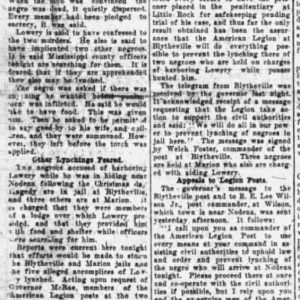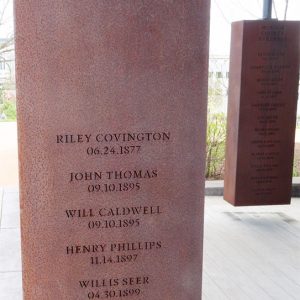calsfoundation@cals.org
Henry Lowery (Lynching of)
The January 26, 1921, lynching of Henry Lowery stands out for its barbarism, as well as the national and international attention it received, happening at a time when the U.S. Congress was debating anti-lynching legislation. The brutal murder of Lowery was used in a national campaign to pass such legislation, though this proved unsuccessful.
Henry Lowery was an African-American tenant farmer in Mississippi County. Lowery is reported to have disputed a matter of payment with a local planter named O. T. Craig, whose land was adjacent to that of Lee Wilson, owner of the largest cotton plantation in the South. On Christmas Day of 1920, Lowery, forty years old at the time, became intoxicated, according to reports, and decided to confront Craig about the matter. He set off for the Craig house and interrupted the family dinner, demanding a settlement. Craig, furious at the interruption, refused. As Lowery was backing off the porch, Craig’s son Dick shot at him, wounding him slightly. Lowery then returned fire, killing Craig and Craig’s adult daughter Mary; both sons survived.
Upon discovery of the crime, a mob went out in search of Lowery but was unable to find him. According to some sources, members of this mob gathered again the next day and marched to the jail in Jonesboro (Craighead County), where an African-American man named Wade Thomas was awaiting trial for the murder of a police officer, and participated in the lynching of him.
Lowery, meanwhile, escaped to El Paso, Texas, with the help of members of the local Black Odd Fellows lodge, where he remained hidden until authorities intercepted a letter he had written to a friend. They informed law enforcement officers in El Paso, who took Lowery into custody and prepared to extradite him back to Arkansas. The officers charged with extraditing Lowery had been warned that men intent on lynching Lowery had been stationed along the direct train route from Texarkana (Miller County) to Little Rock (Pulaski County). To avoid these men, they decided to take a more circuitous route via New Orleans, Louisiana, and Memphis, Tennessee. However, word of this reached Lowery’s would-be murderers, and approximately sixteen men were waiting for the peace officers at the Sardis, Mississippi, station. They disarmed the officers and took Lowery to Nodena (Mississippi County).
The group had planned to take Lowery back to the Craig plantation and lynch him along with two other Black men whom many suspected of having helped him escape. However, the presence of state law enforcement and bad weather made this difficult, and the crowd of at least 500 that had gathered in Nodena grew impatient and demanded Lowery be lynched immediately. The leaders of the mob then chained Lowery to a log and placed leaves soaked in gasoline around his feet. Lowery asked for something to eat and to see his wife and children again, and the mob surprisingly granted both requests. After Lowery’s wife and children had arrived (they had been held hostage in a house behind the Craig house since Lowery’s escape), the mob set the gasoline-soaked leaves on fire. Ralph Roddy, a reporter for the Memphis Press was present and described the horrific killing: “Inch by inch the negro was fair cooked to death. Every few minutes fresh leaves were tossed on the funeral pyre until the blaze had passed the negro’s waist. As the flames were eating away his abdomen, a member of the mob stepped forward and saturated the body with gasoline. It was then only a few minutes until the negro had been reduced to ashes.”
Though Lowery at one point tried to end his own misery by choking himself with the ashes that surrounded him, members of the mob kicked away the ashes, and it took over half an hour for Lowery to die. Despite this, Roddy reported that Lowery did not once beg for mercy. The sons of O. T. Craig were reported to have been in the crowd to witness Lowery’s death.
The lynching brought international attention to the state of Arkansas and its history of lynching. The National Association for the Advancement of Colored People (NAACP) conducted a special investigation of the killing and made it the subject of a pamphlet that was widely circulated. The lynching was reported in newspapers in Chicago, Illinois; New York City, New York; Laredo, Texas; and even as far away as Tokyo, Japan. Arkansas’s governor, Thomas C. McRae, was quoted as saying the lynching was “most disgraceful and inexcusable” and urged an anti-lynching law that would dismiss law officers deemed negligent in lynching cases.
Lowery’s lynching was also used to promote the passing of the anti-lynching Dyer bill at the national level. The pamphlet detailing the gruesome nature of Lowery’s death was distributed to congressmen by the NAACP, and his lynching is among those recorded in the official congressional record of debates surrounding the bill (HR 13). The bill described itself as “An Act to assure to persons within the jurisdiction of every State the equal protection of the laws, and to punish the crime of lynching.” Faced with the horror of Lowery’s and other lynchings, the House of Representatives in 1922 passed the Dyer bill, which also had the support of President Warren G. Harding. However, it failed to pass in the Senate. In 2005, the U.S. Senate issued a formal apology for failing to pass the Dyer bill and other anti-lynching legislation.
For additional information:
Hill, Karlos. Beyond the Rope: The Impact of Lynching on Black Culture and Memory. New York: Cambridge University Press, 2016.
Lewis, Todd. “Mob Justice in the ‘American Congo’: ‘Judge Lynch’ in Arkansas during the Decade after World War I.” Arkansas Historical Quarterly 52 (Summer 1993): 156–184.
“Mob Burns Negro after 100 Mile Trip.” New York World, January 27, 1921, p. 4.
Raiford, L. Imprisoned in a Luminous Glare: Photography and the African American Freedom Struggle. Chapel Hill: University of North Carolina Press, 2011.
Shortridge, M. Congressional Edition. Vol. 7951. Washington DC: United States Congress, 1922.
Stockley, Grif. Ruled by Race: Black/White Relations in Arkansas from Slavery to the Present. Fayetteville: University of Arkansas Press, 2008.
Whayne, Jeannie. Delta Empire: Lee Wilson and the Transformation of Agriculture in the New South. Baton Rouge: Louisiana State University Press, 2011.
———. “Henry Lowery Lynching: A Legacy of the Elaine Massacre?” In Race, Labor, and Violence in the Delta: Essays to Mark the Centennial of the Elaine Massacre, edited by Michael Pierce and Calvin White. Fayetteville: University of Arkansas Press, 2022.
Anitra Van Prooyen
Jacksonville, Arkansas
 Civil Rights and Social Change
Civil Rights and Social Change Early Twentieth Century, 1901 through 1940
Early Twentieth Century, 1901 through 1940 Lowery Lynching Article
Lowery Lynching Article  Mississippi County Lynching
Mississippi County Lynching 



Comments
No comments on this entry yet.